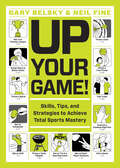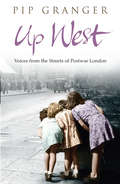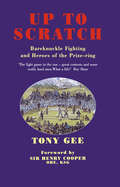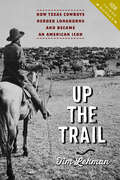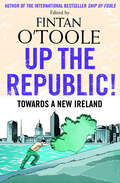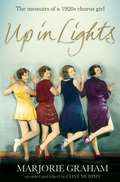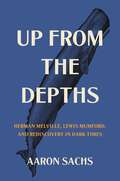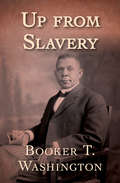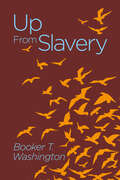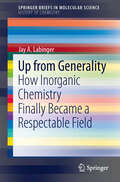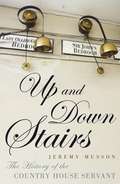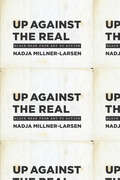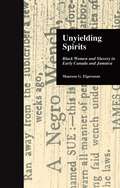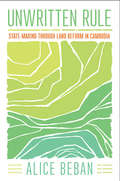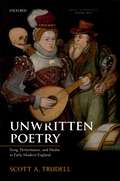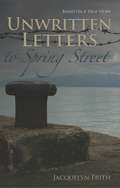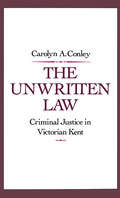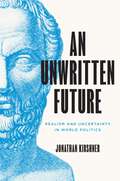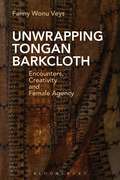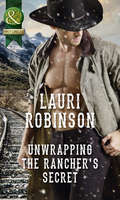- Table View
- List View
Up Your Game!: Skills, Tips, and Strategies to Achieve Total Sports Mastery
by Gary Belsky Neil FineSound smart and play smarter with this compendium of the tricks, techniques, and unwritten rules every sports fan needs—from naming your fantasy team to betting with friends, doing a flip turn to investing in memorabilia, winning at arm wrestling to hosting a Super Bowl party, and so much more. With over 150 to-the-point entries, plus helpful illustrations, charts, and lists, Up Your Game! will get you in the know in no time.
Up West: Voices from the Streets of Post-War London
by Pip GrangerDo you remember the West End of London during the 1950s? Did you live or work there? If so, I want to hear from you ...This was the advertisement author Pip Granger placed in a local newspaper, and the response was immediate. Soon she was hearing from people who recalled what it was like when sweets were rationed; from families who'd been bombed out of their homes during the Blitz; from men who'd worked in the flower markets of Covent Garden; and from the son of a family of immigrants who'd opened one of the very first delicatessens in Soho. All had extraordinary stories to tell.Based on the author's own memories and dozens of interviews and written testimonies, Up West evokes a unique and vibrant community, and a way of life that is vanishing fast.
Up to Scratch: Bareknuckle Fighting and the Heroes of the Prize Ring
by Tony Gee"The fight game in the raw great contests and some really hard men. What a life!" Roy ShawPrize-fighting was one of the greatest sporting attractions in the 18th and 19th centuries. Prize-fights attracted thousands of spectators from all walks of life and, nothwithstanding its illegality, was patronised by royalty and the aristocracy. The area outside London around Barnet, Whetstone, Finchley and up into Hertfordshire was one on the most popular for staging fights. Featured in Up to Scratch are many of the great champions - Tom Johnson, Daniel Mendoza, Jem Belcher, Tom Sayers and Jem Mace - as well as many forgotten but no less colourful fistic heroes.Up To Scratch powerfully evokes an age when pugilism was a barbaric, corrupt and yet primarily noble activity.
Up the Trail: How Texas Cowboys Herded Longhorns and Became an American Icon (How Things Worked)
by Tim LehmanCattle drives were the largest, longest, and ultimately the last of the great forced animal migrations in human history. Spilling out of Texas, they spread longhorns, cowboys, and the culture that roped the two together throughout the American West. In cities like Abilene, Dodge City, and Wichita, buyers paid off ranchers, ranchers paid off wranglers, and railroad lines took the cattle east to the packing plants of St. Louis and Chicago. The cattle drives of our imagination are filled with colorful cowboys prodding and coaxing a line of bellowing animals along a dusty path through the wilderness. These sturdy cowhands always triumph over stampedes, swollen rivers, and bloodthirsty Indians to deliver their mighty-horned companions to market;¢;‚¬;€?but Tim Lehman;€™s Up the Trail reveals that the gritty reality was vastly different. Far from being rugged individualists, the actual cow herders were itinerant laborers;¢;‚¬;€?a proletariat on horseback who connected cattle from the remote prairies of Texas with the nation;€™s industrial slaughterhouses. Lehman demystifies the cowboy life by describing the origins of the cattle drive and the extensive planning, complicated logistics, great skill, and good luck essential to getting the cows to market. He reveals how drives figured into the larger story of postwar economic development and traces the complex effects the cattle business had on the environment. He also explores how the premodern cowboy became a national hero who personified the manly virtues of rugged individualism and personal independence. Grounded in primary sources, this absorbing book takes advantage of recent scholarship on labor, race, gender, and the environment. The lively narrative will appeal to students of Texas and western history as well as anyone interested in cowboy culture.
Up the Republic!: Towards a New Ireland
by Fintan O'TooleIn this important book, historians, lawyers, economists and writers come together to put a coherent case: that although the Irish economic collapse has resulted in national humiliation, renewed emigration and a decline in living standards for the majority of the population, there is still hope that the country can be reformed and renewed.Irish politicians offered the now notorious blanket guarantee to all the banks which had got in over their heads during the great property bubble - including one that had become little more than a criminal enterprise. A different set of politicians grimly enforces the consequences of that guarantee, locking an entire generation of Irish men and women into paying for the mistakes of greedy bankers and their corrupt friends in government.The energy of hope has to come from elsewhere. These essays demonstrate how simple measures and different economic and social policies could release that energy and fulfil the promise of an educated, literate and culturally vibrant people.
Up in Lights: The Memoirs of a 1920s Chorus Girl
by Marjorie GrahamThe touching true story of a young 1920s ‘flapper’, who dreamed of becoming a chorus girl ‘Early that January, there was snow on the ground, and Victoria Carmen took a violent chill. I played Principal Boy in her place. At last! MARJORIE GRAHAM was all alone in electric lights outside the King’s Theatre, Edinburgh!’ Born into an ordinary Edinburgh family in 1904, Marjorie Graham was expected to grow up like any other respectable girl. But her childhood dance classes with friends instilled a burning desire in her: to be a star. She couldn’t have chosen a better time. As the roaring Twenties of jazz, Gatsby and glamour flared into life, young Marjorie got her first break as a chorus girl. But the glamour of being a ‘flapper’ brought with it hidden dangers, an altogether darker world of failed love affairs, poverty and addiction to drink… From chorus girl, to actress, to raconteur and everything in between, this is the touching, tragic story of an ordinary woman with an extraordinary zest for life, whose name was destined to be up in lights.
Up from the Depths: Herman Melville, Lewis Mumford, and Rediscovery in Dark Times
by Professor Aaron SachsA double portrait of two of America’s most influential writers that reveals the surprising connections between them—and their uncanny relevance to our age of crisisUp from the Depths tells the interconnected stories of two of the most important writers in American history—the novelist and poet Herman Melville (1819–1891) and one of his earliest biographers, the literary critic and historian Lewis Mumford (1895–1990). Deftly cutting back and forth between the writers, Aaron Sachs reveals the surprising resonances between their lives, work, and troubled times—and their uncanny relevance in our own age of crisis.The author of Moby-Dick was largely forgotten for several decades after his death, but Mumford helped spearhead Melville’s revival in the aftermath of World War I and the 1918–1919 flu pandemic, when American culture needed a forebear with a suitably dark vision. As Mumford’s career took off and he wrote books responding to the machine age, urban decay, world war, and environmental degradation, it was looking back to Melville’s confrontation with crises such as industrialization, slavery, and the Civil War that helped Mumford to see his own era clearly. Mumford remained obsessed with Melville, ultimately helping to canonize him as America’s greatest tragedian. But largely forgotten today is one of Mumford’s key insights—that Melville’s darkness was balanced by an inspiring determination to endure.Amid today’s foreboding over global warming, racism, technology, pandemics, and other crises, Melville and Mumford remind us that we’ve been in this struggle for a long time. To rediscover these writers today is to rediscover how history can offer hope in dark times.
Up from the Depths: Herman Melville, Lewis Mumford, and Rediscovery in Dark Times
by Professor Aaron SachsA double portrait of two of America’s most influential writers that reveals the surprising connections between them—and their uncanny relevance to our age of crisisUp from the Depths tells the interconnected stories of two of the most important writers in American history—the novelist and poet Herman Melville (1819–1891) and one of his earliest biographers, the literary critic and historian Lewis Mumford (1895–1990). Deftly cutting back and forth between the writers, Aaron Sachs reveals the surprising resonances between their lives, work, and troubled times—and their uncanny relevance in our own age of crisis.The author of Moby-Dick was largely forgotten for several decades after his death, but Mumford helped spearhead Melville’s revival in the aftermath of World War I and the 1918–1919 flu pandemic, when American culture needed a forebear with a suitably dark vision. As Mumford’s career took off and he wrote books responding to the machine age, urban decay, world war, and environmental degradation, it was looking back to Melville’s confrontation with crises such as industrialization, slavery, and the Civil War that helped Mumford to see his own era clearly. Mumford remained obsessed with Melville, ultimately helping to canonize him as America’s greatest tragedian. But largely forgotten today is one of Mumford’s key insights—that Melville’s darkness was balanced by an inspiring determination to endure.Amid today’s foreboding over global warming, racism, technology, pandemics, and other crises, Melville and Mumford remind us that we’ve been in this struggle for a long time. To rediscover these writers today is to rediscover how history can offer hope in dark times.
Up from Slavery
by Booker T. WashingtonBooker T. Washington’s classic memoir of enslavement, emancipation, and community advancement in the Reconstruction Era. Born into slavery on a tobacco farm in nineteenth-century Virginia, Booker T. Washington became one of the most powerful intellectuals of the Reconstruction Era. As president of the Tuskegee Institute in Alabama, he advocated for the advancement of African Americans through education and entrepreneurship. In Up from Slavery, Washington speaks frankly and honestly about his enslavement and emancipation, struggle to receive an education, and life’s work as an educator. In great detail, Washington describes establishing the Tuskegee Institute, from teaching its first classes in a hen house to building a prominent institution through community organization and a national fundraising campaign. He also addresses major issues of the era, such as the Jim Crow laws, Ku Klux Klan, and “false foundation” of Reconstruction policy. Up From Slavery is based on biographical articles written for the Christian newspaper Outlook and includes the full text of Washington’s revolutionary Atlanta Exposition address. First published in 1901, this powerful autobiography remains a landmark of African American literature as well as an important firsthand account of post–Civil War American history. This ebook has been professionally proofread to ensure accuracy and readability on all devices.
Up From Slavery (Arcturus Classics)
by Booker T. WashingtonFirst published in 1901, Up From Slavery is the autobiography of the renowned civil rights activist, educator, and presidential advisor, Booker T. Washington. Praised for its wisdom and common sense, this inspirational work rightly became a bestseller.Recounting Washington's efforts to gain an education after the Civil War and his subsequent struggle for racial equality, Up From Slavery combines a fascinating tale of perseverance and tireless campaigning together with astute observations about the society in which he lived.More than 100 years later, Washington's story is as powerful as it ever was.
Up from Generality: How Inorganic Chemistry Finally Became a Respectable Field (SpringerBriefs in Molecular Science)
by Jay A. LabingerIn this brief, renowned inorganic chemist Jay Labinger tracks the development of his field from a forgotten specialism to the establishment of an independent, intellectually viable discipline. Inorganic chemistry, with a negation in its very name, was long regarded as that which was left behind when organic and physical chemistry emerged as specialist fields in the 19th century. Only by the middle of the 20th century had it begun to gain its current stature of equality to that of the other main branches of chemistry. The author discusses the evidence for this transition, both quantitative and anecdotal and includes consideration of the roles of local and personal factors, with particular focus on Caltech as an illustrative example. This brief is of interest both to historians of science and inorganic chemists who would like to find out how their field began.
Up and Down Stairs: The History of the Country House Servant
by Jeremy MussonCountry houses were reliant on an intricate hierarchy of servants, each of whom provided an essential skill. Up and Down Stairs brings to life this hierarchy and shows how large numbers of people lived together under strict segregation and how sometimes this segregation was broken, as with the famous marriage of a squire to his dairymaid at Uppark. Jeremy Musson captures the voices of the servants who ran these vast houses, and made them work. From unpublished memoirs to letters, wages, newspaper articles, he pieces together their daily lives from the Middle Ages through to the twentieth century. The story of domestic servants is inseparable from the story of the country house as an icon of power, civilisation and luxury. This is particularly true with the great estates such as Chatsworth, Hatfield, Burghley and Wilton. Jeremy Musson looks at how these grand houses were, for centuries, admired and imitated around the world.
Up Against the Real: Black Mask from Art to Action
by Nadja Millner-LarsenA history of 1960s activist art group Black Mask. With Up Against the Real, Nadja Millner-Larsen offers the first comprehensive study of the group Black Mask and its acrimonious relationship to the New York art world of the 1960s. Cited as pioneers of now-common protest aesthetics, the group’s members employed incendiary modes of direct action against racism, colonialism, and the museum system. They shut down the Museum of Modern Art, fired blanks during a poetry reading, stormed the Pentagon in an antiwar protest, sprayed cow’s blood at the secretary of state, and dumped garbage into the fountain at Lincoln Center. Black Mask published a Dadaist broadside until 1968, when it changed its name to Up Against the Wall Motherfucker (after line in a poem by Amiri Baraka) and came to classify itself as “a street gang with analysis.” American activist Abbie Hoffman described the group as “the middle-class nightmare . . . an anti-media phenomenon simply because their name could not be printed.” Up Against the Real examines how and why the group ultimately rejected art in favor of what its members deemed “real” political action. Exploring this notorious example of cultural activism that rose from the ruins of the avant-garde, Millner-Larsen makes a critical intervention in our understanding of political art.
Unyielding Spirits: Black Women and Slavery in Early Canada and Jamaica (Crosscurrents in African American History)
by Maureen G. ElgersmanFirst Published in 1999. Routledge is an imprint of Taylor & Francis, an informa company.
Unyielding Spirits: Black Women and Slavery in Early Canada and Jamaica (Crosscurrents in African American History #6)
by Maureen G. ElgersmanFirst Published in 1999. Routledge is an imprint of Taylor & Francis, an informa company.
Unwritten Rule: State-Making through Land Reform in Cambodia (Cornell Series on Land: New Perspectives on Territory, Development, and Environment)
by Alice BebanIn 2012, Cambodia—an epicenter of violent land grabbing—announced a bold new initiative to develop land redistribution efforts inside agribusiness concessions. Alice Beban's Unwritten Rule focuses on this land reform to understand the larger nature of democracy in Cambodia. Beban contends that the national land-titling program, the so-called leopard skin land reform, was first and foremost a political campaign orchestrated by the world's longest-serving prime minister, Hun Sen. The reform aimed to secure the loyalty of rural voters, produce "modern" farmers, and wrest control over land distribution from local officials. Through ambiguous legal directives and unwritten rules guiding the allocation of land, the government fostered uncertainty and fear within local communities. Unwritten Rule gives pause both to celebratory claims that land reform will enable land tenure security, and to critical claims that land reform will enmesh rural people more tightly in state bureaucracies and create a fiscally legible landscape. Instead, Beban argues that the extension of formal property rights strengthened the very patronage-based politics that Western development agencies hope to subvert.
Unwritten Rome
by T. WisemanIn Unwritten Rome, a new book by the author of Myths of Rome, T.P. Wiseman presents us with an imaginative and appealing picture of the early society of pre-literary Rome—as a free and uninhibited world in which the arts and popular entertainments flourished. This original angle allows the voice of the Roman people to be retrieved empathetically from contemporary artefacts and figured monuments, and from selected passages of later literature.How do you understand a society that didn’t write down its own history? That is the problem with early Rome, from the Bronze Age down to the conquest of Italy around 300 BC. The texts we have to use were all written centuries later, and their view of early Rome is impossibly anachronistic. But some possibly authentic evidence may survive, if we can only tease it out – like the old story of a Roman king acting as a magician, or the traditional custom that may originate in the practice of ritual prostitution. This book consists of eighteen attempts to find such material and make sense of it.
Unwritten Poetry: Song, Performance, and Media in Early Modern England
by Scott A. TrudellVocal music was at the heart of English Renaissance poetry and drama. Virtuosic actor-singers redefined the theatrical culture of William Shakespeare and his peers. Composers including William Byrd and Henry Lawes shaped the transmission of Renaissance lyric verse. Poets from Philip Sidney to John Milton were fascinated by the disorienting influx of musical performance into their works. Musical performance was a driving force behind the period's theatrical and poetic movements, yet its importance to literary history has long been ignored or effaced. This book reveals the impact of vocalists and composers upon the poetic culture of early modern England by studying the media through which—and by whom—its songs were made. In a literary field that was never confined to writing, media were not limited to material texts. Scott Trudell argues that the media of Renaissance poetry can be conceived as any node of transmission from singer's larynx to actor's body. Through his study of song, Trudell outlines a new approach to Renaissance poetry and drama that is grounded not simply in performance history or book history but in a more synthetic media history.
Unwritten Poetry: Song, Performance, and Media in Early Modern England
by Scott A. TrudellVocal music was at the heart of English Renaissance poetry and drama. Virtuosic actor-singers redefined the theatrical culture of William Shakespeare and his peers. Composers including William Byrd and Henry Lawes shaped the transmission of Renaissance lyric verse. Poets from Philip Sidney to John Milton were fascinated by the disorienting influx of musical performance into their works. Musical performance was a driving force behind the period's theatrical and poetic movements, yet its importance to literary history has long been ignored or effaced. This book reveals the impact of vocalists and composers upon the poetic culture of early modern England by studying the media through which—and by whom—its songs were made. In a literary field that was never confined to writing, media were not limited to material texts. Scott Trudell argues that the media of Renaissance poetry can be conceived as any node of transmission from singer's larynx to actor's body. Through his study of song, Trudell outlines a new approach to Renaissance poetry and drama that is grounded not simply in performance history or book history but in a more synthetic media history.
Unwritten Letters to Spring Street
by Jacquelyn FrithDecember 1941. Jack Frith left his family and his life to go to war like so many others, uncertain whether he would come home. Whilst in a convoy bound for the Middle East the Japanese attacked Pearl Harbour, triggering Allied entry into the Pacific War. Hastily regrouped and ordered to the Far East, the now ill-equipped convoy peeled off for Java and elsewhere. Slipping the moorings, Jack could not have known that years of captivity and brutality, starvation and forced labour, and yet worse, awaited him. This is no cry for revenge but justice, laying bare actions and exposing inaction, demanding long overdue apologies and uncovering past atrocities. It is also a moment of reflection on the forgotten armies of the Far East, in remembering each subsequent generation owes a great unpaid debt of gratitude to those who gave so much for our present freedom. The price of that freedom was by no means free.
The Unwritten Law: Criminal Justice in Victorian Kent
by Carolyn A. ConleyThe Unwritten Law examines the values and assumptions of mid-Victorian England as revealed in the actual workings of the criminal justice system. The working definitions of criminality and justice were often influenced more by certain tacit assumptions than by the written law. Through a careful study of the ways that the status and circumstances of victims and suspects influenced judicial decisions, Conley provides important new insights into Victorian attitudes toward violence, women, children, community, and the all-important concept of respectability. She also addresses issues that continue to be of concern in today's society: How can equal justice be preserved when social and economic conditions and expectations are not equal? How can the rights of the accused be reconciled with those of victims--especially children? Can and should the courts interfere with the traditions of family and community? What standards can determine the criminality of a particular act and the justice and efficacy of punishment? This original analysis will hold special interest for students and scholars of British history, social history, and criminality and the law.
An Unwritten Future: Realism and Uncertainty in World Politics (Princeton Studies in International History and Politics #186)
by Jonathan KirshnerAn argument for the classical realist approach to world politics An Unwritten Future offers a fresh reassessment of classical realism, an enduring approach to understanding crucial events in the international political arena. Jonathan Kirshner identifies the fundamental flaws of classical realism&’s would-be successors and shows how this older, more nuanced and sophisticated method for studying world politics better explains the formative events of the past. Kirshner also reveals how this approach is ideally equipped to comprehend the vital questions of the present—such as the implications of China&’s rise, the ways that social and economic change alter the balance of power and the nature of international conflict, and the consequences of the end of the US-led postwar order for the future of world politics.Laying out realism&’s core principles, Kirshner discusses the contributions of the perspective&’s key thinkers, including Thucydides, Hans Morgenthau, and Raymond Aron, among others. He illustrates how a classical realist approach gives new insights into major upheavals of the twentieth century, such as Britain&’s appeasement of Nazi Germany and America&’s ruinous involvement in Vietnam. Kirshner also addresses realism&’s limits and explores contemporary issues, including the ascent of great power challengers, the political implications of globalization, and the diffusion of power in modern world politics.A reexamination of the realist tradition, with a renewed emphasis on the crucial roles played by uncertainty, contingency, and contestation, An Unwritten Future demonstrates how a once-popular school of thought provides invaluable insights into pressing real-world problems.
Unwrapping Tongan Barkcloth: Encounters, Creativity and Female Agency
by Fanny Wonu VeysTongan barkcloth, made from the inner bark of the paper mulberry tree, still features lavishly in Polynesian ceremonies all over the world. Yet despite the attention paid to this textile by anthropologists and art historians alike, little is known about its history. Providing a unique insight into Polynesian material culture, this book explores barkcloth's rich cultural history, and argues that its manufacture, decoration and use are vehicles of creativity and female agency. Based on twelve years of extensive ethnographic and archival research, the book uncovers stories of ceremony, gender, the senses, religion and nationhood, from the 17th century up to the present-day. Placing the materiality of textiles at the heart of Tongan culture, Veys reveals not only how barkcloth was and continues to be made, but also how it defines what it means to be Tongan. Extending the study to explore the place of barkcloth in the European imagination, she examines international museum collections of Tongan barkcloth, from the UK and Italy to Switzerland and the USA, addressing the bias of the European 'gaze' and challenging traditional gendered understandings of the cloth. A nuanced narrative of past and present barkcloth manufacture, designs and use, Unwrapping Tongan Barkcloth demonstrates the importance of the textile to both historical and contemporary Polynesian culture.
Unwrapping Tongan Barkcloth: Encounters, Creativity and Female Agency
by Fanny Wonu VeysTongan barkcloth, made from the inner bark of the paper mulberry tree, still features lavishly in Polynesian ceremonies all over the world. Yet despite the attention paid to this textile by anthropologists and art historians alike, little is known about its history. Providing a unique insight into Polynesian material culture, this book explores barkcloth's rich cultural history, and argues that its manufacture, decoration and use are vehicles of creativity and female agency. Based on twelve years of extensive ethnographic and archival research, the book uncovers stories of ceremony, gender, the senses, religion and nationhood, from the 17th century up to the present-day. Placing the materiality of textiles at the heart of Tongan culture, Veys reveals not only how barkcloth was and continues to be made, but also how it defines what it means to be Tongan. Extending the study to explore the place of barkcloth in the European imagination, she examines international museum collections of Tongan barkcloth, from the UK and Italy to Switzerland and the USA, addressing the bias of the European 'gaze' and challenging traditional gendered understandings of the cloth. A nuanced narrative of past and present barkcloth manufacture, designs and use, Unwrapping Tongan Barkcloth demonstrates the importance of the textile to both historical and contemporary Polynesian culture.
